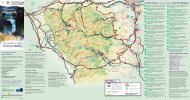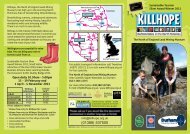How a visit to Killhope can inspire
How a visit to Killhope can inspire
How a visit to Killhope can inspire
Create successful ePaper yourself
Turn your PDF publications into a flip-book with our unique Google optimized e-Paper software.
UNIT 3D: ROCKS AND SOILS<br />
Using <strong>Killhope</strong>: <strong>Killhope</strong> is an excellent context in which <strong>to</strong> study rocks and soils. There are<br />
diverse areas of the site – woodland, reservoirs, ditches, a river, the Washing Floor, and the mine<br />
itself, where a number of different types of soils which <strong>can</strong> be studied. The rocks and minerals on<br />
site are displayed <strong>to</strong> promote discussion of their uses and characteristics. We have minerals which<br />
<strong>can</strong> be handled by the children so they <strong>can</strong> test their properties. A <strong>visit</strong> underground or in<strong>to</strong> the<br />
woodland will reveal the rock underneath the soil, and <strong>can</strong> support studies of permeability and<br />
erosion.<br />
LEARNING OBJECTIVES POSSIBLE ACTIVITIES LEARNING OUTCOMES<br />
Looking at rocks<br />
• That rocks are used for a<br />
variety of purposes.<br />
• That rocks <strong>can</strong> be grouped<br />
according <strong>to</strong> observable<br />
characteristics.<br />
• To observe and compare<br />
rocks.<br />
• That differences between<br />
rocks <strong>can</strong> be identified by<br />
testing.<br />
• That rocks are chosen for<br />
particular purposes<br />
because of their<br />
characteristics.<br />
• Review the differences between<br />
naturally occurring rocks and<br />
those which do not. Look at the<br />
different types of rock at <strong>Killhope</strong><br />
and explain why they are used<br />
for particular purposes, eg walls<br />
or roofing. <strong>How</strong> did the miners<br />
use the minerals they found for?<br />
What are those minerals used for<br />
now?<br />
Grouping rocks<br />
• Present the children with a<br />
collection of rocks from our<br />
mineral room <strong>to</strong> observe and<br />
group. Ask children <strong>to</strong> choose<br />
criteria for grouping, and ask the<br />
others <strong>to</strong> guess what it is.<br />
Erosion and permeability<br />
• Compare how easily rocks are<br />
worn along the riverbanks and<br />
ditches. Look at the shakeholes<br />
in the woodland that were<br />
created by erosion.<br />
• Why were the ditches lined with<br />
clay?.<br />
• Go in<strong>to</strong> the mine and feel the<br />
drip of water <strong>to</strong> see how<br />
permeable the rock is.<br />
Using rocks<br />
• Look at the different types of<br />
rock that are used on site. Why<br />
have different rocks been chosen<br />
for building and roofing?<br />
• Identify some rocks<br />
and identify why they<br />
are used for a<br />
particular purpose.<br />
• Group rocks according<br />
<strong>to</strong> differences in<br />
texture and record and<br />
justify the groupings.<br />
• Allocate an additional<br />
rock <strong>to</strong> a group and<br />
explain the decision.<br />
• Use results of the tests<br />
<strong>to</strong> rank rocks in order<br />
of ease of wearing<br />
away.<br />
• Relate the use of<br />
particular rocks <strong>to</strong> their<br />
characteristics and<br />
explain why they are<br />
used<br />
42







